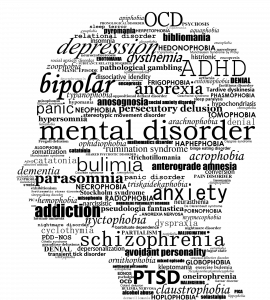Mental illness is such a vast subject. There are more than 200 diagnosed mental illnesses such as depression, anxiety disorder, bipolar disorder, schizophrenia, dementia, attention-deficit/hyperactivity disorder (ADHD), autism, and post-traumatic stress disorder, to name a few. Depression, anxiety, bipolar disorder, and schizophrenia are some of the most common disorders. Almost all people globally suffer from some form of mental disorder at least once in their lifetime.
According to the National Institute of Mental Health, in the US, nearly one in five adults live with a mental disorder accounting for approximately 47 million people in 2017 (19% of the population). The prevalence of any mental illness is higher in women (22.3%) than men (15%). Young adults between the ages of 18-25 years have the highest prevalence of any mental illness (25.8%) followed by adults aged 26-49 years (22%) and those aged 50 years and older (13.8%). Unfortunately, only about 42.8% or 20 million people receive the appropriate care they need to combat mental disorders. Even more disturbing is the fact that of all young adults aged 18-25 years, only about 38.5% received care, the lowest for any age group.
The statistics bring us to two very crucial questions. Why is the prevalence of mental disorders high, particularly in women and young adults? The second important question is why are more than half of those with mental health problems silent about the same?
The different gender-specific rates of mental health might be related to gender-based roles, stressors, and negative life experiences. According to the World Health Organization, factors like violence on women, low socioeconomic stratum, income disparity, inequality, sexual income, and increased workload might be the causes for this difference. The rise of social media, the need to validate oneself, peer pressure, and increased stressors are to be blamed for high rates of mental disorders among young adults.
This brings us to the next vital question. Why is the percentage of people seeking help for mental illness is low? It might be due to the stigma associated with the discussion about mental health. Stigma is defined as a mark of disgrace or infamy; a stain or reproach, as on one’s reputation. As Psychology Today explains there are two types of mental health stigma: social stigma and perceived stigma. Social stigma is the biased attitude and discriminatory behavior towards individuals with mental health because of the label they have been given. For instance, the belief that people with mental disorders, especially schizophrenia, bipolar disorder, etc. are dangerous, or the belief that mental disorders are not real. On the other hand, perceived stigma or self-stigma is the internalizing by the mental health sufferer of their perceptions of the discrimination. Additionally, such stigmatizing beliefs are not only held by strangers, but also, most commonly, by family members, friends, and peers. Mental disorders not only affect physical health but might also lead to loss of employment, loss of family or relationships, alienation, and unfortunately, suicide, in some extreme cases.
In such unprecedented times, the effects of mental disorders are particularly aggravated. COVID-19 pandemic has taken the world storm. Isolation, social distancing, online campus, almost negligible interaction with peers, unemployment, and being locked indoors have increased the mental health symptoms in those already suffering from some form of mental disorders and have introduced signs and symptoms in the others. These effects can be seen in college students, women, and middle-aged men. A recent Active Minds survey found that 89% of college students say that they are experiencing major stress and anxiety due to COVID-19. Not being able to move outdoors and being stuck alone has drastically increased stressors and negativity. The loss of employment, lack of sufficient salary, and closing of businesses have taken a toll on the mental health of middle-aged men. Additionally, a lot of women who were abused or had suffered from physical violence are now locked in homes with their abusers. This has led to increasing rates of depression and anxiety among women, especially those in the lower socio-economic stratum. The effect is particularly severe in low- and middle-income countries which has a large labor population. Loss of jobs, lack of existing resources, and unaffordable care have been extremely damaging.
This explains the importance of recognizing and fighting mental disorders. There is a lot of resource and help available to those suffering from mental disorders. However, the help is all worthless unless the world is rid of the stigma associated with mental health. The National Alliance on Mental Health talks about ways to help with the stigma surrounding mental health. The most vital first step is talking openly about the struggle with mental health and educating yourself and the people around you about its importance. Being compassionate to those with mental health, empowering people to fight against it, and most importantly, discouraging any negative comments or adjectives associated with mental health, on social media, television, in conversations, or otherwise. These are some of the most critical ways to equalize physical health and mental health, which is the first step in the fight against mental disorders. There are several organizations like the National Institute of Mental Health, American Psychological Association, and helplines like suicide prevention helpline, mental health mobile crisis team, which are constantly motivating and encouraging people to fight and overcome mental disorders, and not succumb to those.
Despite a vast number of resources, the growing numbers are a wake-up call. The prevalence of mental disorders, especially depression and anxiety, calls for coordinated efforts across the globe.





There are no comments yet...Kick things off by filling out the form below.